Typical values at TA = +25°C, ADC
Sampling Rate = 2949.12 GHz. Default conditions: output sample rate = 491.52 MSPS
(decimate by 6), PLL clock mode with fREF = 491.52 MHz, AIN =
–3 dBFS, DSA setting = 4 dB.
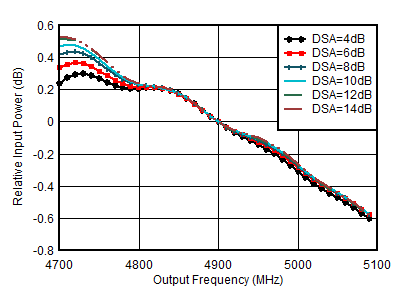
| With matching, normalized to power at 4.9GHz for each DSA setting |

| With
4.9 GHz matching, normalized to phase at 25°C |
|
|
Figure 6-175 RX
Input Phase vs Temperature and DSA at fOUT = 4.9 GHz
| With
4.9 GHz matching |
| Differential Amplitude Error = PIN (DSA
Setting – 1) – PIN (DSA Setting) + 1 |
Figure 6-177 RX
Calibrated Differential Amplitude Error vs DSA Setting at 4.9 GHz
| With
4.9 GHz matching |
| Integrated Amplitude Error = PIN (DSA
Setting) – PIN (DSA Setting = 0) + (DSA
Setting) |
Figure 6-179 RX
Calibrated Integrated Amplitude Error vs DSA Setting at 4.9 GHz
| With
4.9 GHz matching |
| Differential Phase Error = PhaseIN (DSA
Setting – 1) – PhaseIN (DSA Setting) |
Figure 6-181 RX
Calibrated Differential Phase Error vs DSA Setting at 4.9 GHz
| With
4.9 GHz matching |
| Integrated Phase Error = Phase (DSA Setting) – Phase
(DSA Setting = 0) |
Figure 6-183 RX
Calibrated Integrated Phase Error vs DSA Setting at 4.9 GHz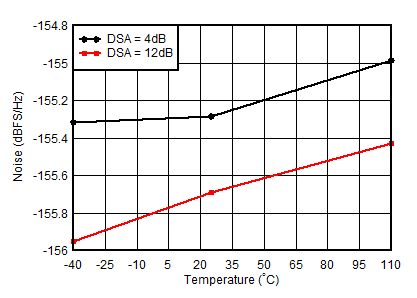
| With 4.9 GHz matching, 12.5-MHz offset from tone |
|

| With
4.9 GHz matching, 12.5-MHz offset from tone |
|
Figure 6-187 RX
Noise Spectral Density vs Input Amplitude and Channel at 4.9 GHz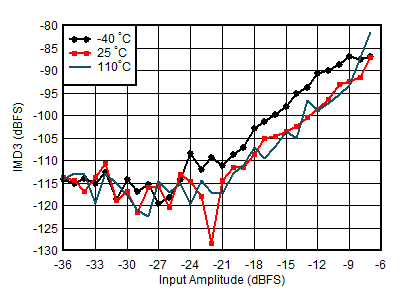
| With 4.9 GHz matching, tone spacing = 20 MHz, DSA = 4 dB |
|

| With
4.9 GHz matching, measured after HD2 trim, DDC bypass
mode (TI only mode for characterization) |
Figure 6-191 RX
HD2 vs DSA Setting and Channel at 4.9 GHz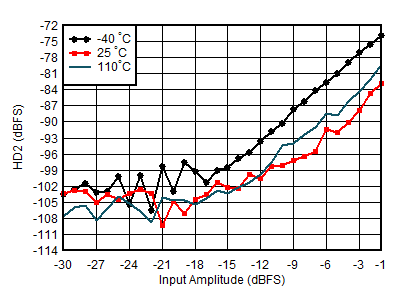
| With 4.9 GHz matching, measured after HD2 trim, DDC bypass mode (TI only mode for characterization) |
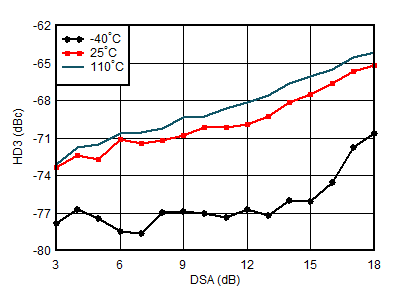
| With 4.9 GHz matching, DDC bypass mode (TI only mode for characterization) |
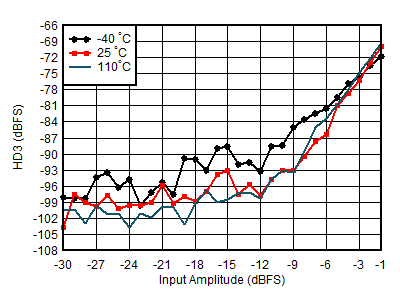
| With 4.9 GHz matching, DDC bypass mode (TI only mode for characterization) |
 Figure 6-199 RX
Non-HD2/3 vs DSA Setting at 4.9 GHz
Figure 6-199 RX
Non-HD2/3 vs DSA Setting at 4.9 GHz
| With
4.9 GHz matching, 12.5-MHz offset, all supplies at MIN,
TYP, or MAX recommended operating voltages |
|
Figure 6-201 RX
Noise Spectral Density vs Supply and Channel at 4.9 GHz
| With
4.9 GHz matching, normalized to fullscale at 25°C for
each channel |
Figure 6-174 RX
Input Fullscale vs Temperature and Channel at 4.9 GHz
| With
4.9 GHz matching |
| Differential Amplitude Error = PIN (DSA
Setting – 1) – PIN (DSA Setting) + 1 |
Figure 6-176 RX
Uncalibrated Differential Amplitude Error vs DSA Setting at 4.9 GHz
| With
4.9 GHz matching |
| Integrated Amplitude Error = PIN (DSA
Setting) – PIN (DSA Setting = 0) + (DSA
Setting) |
Figure 6-178 RX
Uncalibrated Integrated Amplitude Error vs DSA Setting at 4.9 GHz
| With
4.9 GHz matching |
| Differential Phase Error = PhaseIN (DSA
Setting – 1) – PhaseIN (DSA Setting) |
Figure 6-180 RX
Uncalibrated Differential Phase Error vs DSA Setting at 4.9 GHz
| With
4.9 GHz matching |
| Integrated Phase Error = Phase (DSA Setting) – Phase
(DSA Setting = 0) |
Figure 6-182 RX
Uncalibrated Integrated Phase Error vs DSA Setting at 4.9 GHz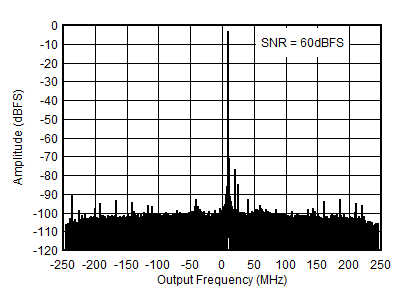
| With 4.9 GHz matching, fIN = 4910 MHz, AIN= –3 dBFS |
|
|
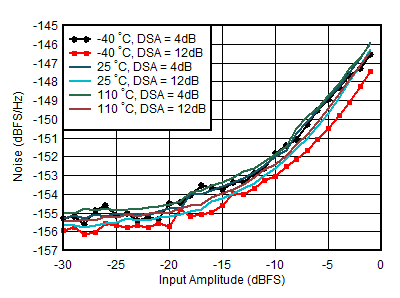
| With 4.9 GHz matching, DSA Setting = 12 dB, 12.5-MHz offset from tone |
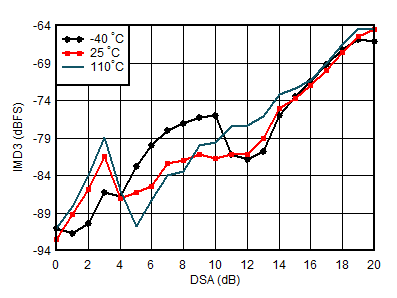
| With 4.9 GHz matching, each tone –7 dBFS, tone spacing = 20 MHz |
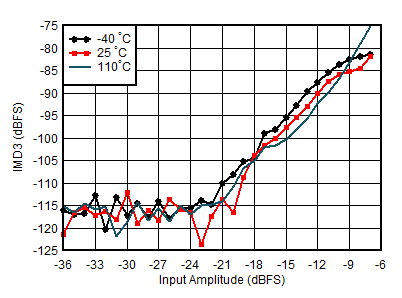
| With 4.9 GHz matching, tone spacing = 20 MHz, DSA = 12 dB |
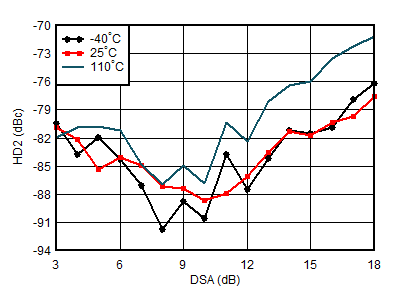
| With 4.9 GHz matching, measured after HD2 trim, DDC bypass mode (TI only mode for characterization) |

| With
4.9 GHz matching, DDC bypass mode (TI only mode for
characterization) |
Figure 6-194 RX
HD3 vs DSA Setting and Channel at 4.9 GHz
| With
4.9 GHz matching, DDC bypass mode (TI only mode for
characterization) |
Figure 6-196 RX
HD3 vs Input Level and Channel at 4.9 GHz
| With
4.9 GHz matching, decimate by 3 |
Figure 6-198 RX
In-Band SFDR (±400 MHz) vs Input Amplitude and Channel at 4.9 GHz
| With
4.9 GHz matching, –7 dBFS each tone, 20-MHz tone
spacing, all supplies at MIN, TYP, or MAX recommended
operating voltages |
Figure 6-200 RX
IMD3 vs Supply and Channel at 4.9 GHz



























